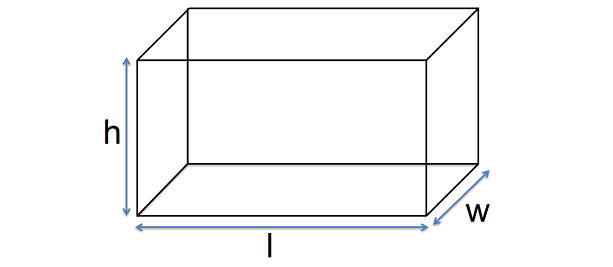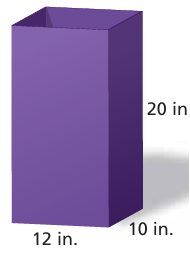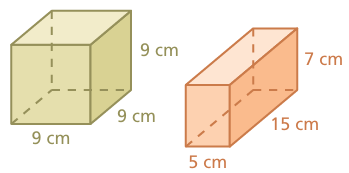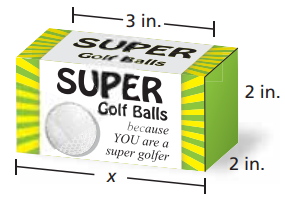SOLVING WORD PROBLEMS WITH CUBOID
Subscribe to our ▶️ YouTube channel 🔴 for the latest videos, updates, and tips.

Formulas given below can be used to find volume, lateral surface area and total surface of a cuboid.
Volume = l x w x h cubic units
Lateral surface area = 2h(l + w) square units
Total surface area = 2(lw + wh + hl) squareunits
Problem 1 :
Find the total surface area and lateral surface area of a cuboid whose length is 20 cm, width is 15 cm and height is 8 cm.
Solution :
Total surface area :
= 2(lw + wh + hl)
Substitute.
= 2[20(15) + 15(8) + 8(20)]
= 2 [300 + 120 + 160]
= 2(580)
= 1160 cm2
Lateral surface area :
= 2h(l + w)
Substitute.
= 2(8)(20 + 15)
= 16(35)
= 560 cm2
Problem 2 :
The dimensions of a cuboidal box are 6 m x 400 cm x 1.5 m. Find the cost of painting its entire outer surface at the rate of $22 per square meter.
Solution :
From the given information,
length (l) = 6 m
width (w) = 400 cm = 400/100 m = 4 m
height = 1.5 m
Outer surface area has six sides.
Then, the required area is
= 2(lw + wh + hl)
Substitute.
= 2[6(4) + 4(1.5) + 1.5(6)]
= 2[24 + 6 + 9]
= 2[39]
= 78 m2
Cost of painting the surface is $22 per m2.
So, the required cost is
= 78(22)
= $1716
Problem 3 :
The dimensions of a hall is 10 m x 9 m x 8 m. Find the cost of white washing the walls and ceiling at the rate of $8.50 per square meter.
Solution :
From the given information,
length (l) = 10 m
width (w) = 9 m
height = 8 m
Area of white washing is
= 2h(l + w) + lw
Substitute.
= 2(8)(10 + 9) + 10(9)
= 16(19) + 90
= 304 + 90
= 394 m2
Cost of white washing is $8.50 per m2.
So, the required cost is
= 394(8.50)
= $3349
Problem 4 :
The length, width and depth of a pond are 20.5 m, 16 m and 8 m respectively. Find the capacity of the pond in liters.
Solution :
l = 20.5 m, w = 16 m, h = 8 m
Capacity of pond :
= lx w x h
= 20.5(16)(8)
= 2624 m3
1 m3 = 1000 liters,
= 2624(1000) liters
= 2624000 liters
Problem 5 :
The outsides of purple traps are coated with glue to catch emerald ash borers. You make your own trap in the shape of a rectangular prism with an open top and bottom. What is the surface area that you need to coat with glue?

Solution :
Faces to be covered with glue are front, back, side faces
Length = 12 inches
Width = 10 inches
Height = 20 inches
Lateral surface area = 2lh + 2wh
= 2h(l + w)
= 2(20)(12 + 10)
= 40 (22)
= 880 square inches
Problem 6 :
Which prism has the greater surface area?

Solution :
Total surface area of rectangular prism = 2(lw + wh + hl)
Total surface area of cube = 6a2
Side length of cube = 9 cm
length = 15 cm, width = 5 cm and height = 7 cm
= 2[15(5) + 5(7) + 7(15)]
= 2[75 + 35 + 105]
= 2(215)
= 430 cm square.
Surcea area of cube = 6(9)2
= 6(81)
= 486 cm square
Problem 7 :
A public library has an aquarium in the shape of a rectangular prism. The base is 6 feet by 2.5 feet. The height is 4 feet. How many square feet of glass were used to build the aquarium? (The top of the aquarium is open.)

Solution :
To create a aquarium, we need to cover five faces.
Area of front and back + area of side faces + area of bottom
= 2(length x height) + 2(width x height) + length x width
length = 6 feet, width = 2.5 feet and height = 4 feet
= 2(6 x 4) + 2(2.5 x 4) + (4 x 2.5)
= 2(24) + 2(1) + 10
= 48 + 2 + 10
= 60 sqaure feet
So, to make a aquarium, we need 60 square feet of glass.
Problem 8 :
A label that wraps around a box of golf balls covers 75% of its lateral surface area. What is the value of x?

Solution :
Measures of lable :
length = 3 inches, width = 2 inches and height = 2 inches
Measures of box :
Length = x, width = 2 inches and height = 2 inches
Lateral surface area = 2
Surface area = 2 lh + 2lw
= 2l(h + w)
Surface area covered by lable = 75% of surface area covered by box
2(3)(2 + 2) = 75% of 2(x)(2 + 2)
6(4) = 0.75(2x)(4)
6 = 1.5x
x = 6/1.5
x = 4 feet
So, the required length of the box is 4 feet.
Problem 9 :
Write a formula for the surface area of a rectangular prism using the height h, the perimeter P of a base, and the area B of a base.
Solution :
Height of the rectangular prism = h
Perimeter of the base = P
Area of the base = B
Total surface area of rectangular prism = 2(lw + w h + hl)
= 2lw + 2w h + 2hl
Area of base of top and bottom = 2 l w ==> 2 B
2wh + 2hl = 2h(w + l)
= 2(w + l) h
= hP
Replacing the above values in the formula, we get
total surface area of rectangular prism = 2B + Ph
Subscribe to our ▶️ YouTube channel 🔴 for the latest videos, updates, and tips.
Kindly mail your feedback to v4formath@gmail.com
We always appreciate your feedback.
About Us | Contact Us | Privacy Policy
©All rights reserved. onlinemath4all.com
Recent Articles
-
10 Hard SAT Math Questions (Part - 40)
Dec 18, 25 06:27 PM
10 Hard SAT Math Questions (Part - 40) -
Digital SAT Math Problems and Solutions (Part - 13)
Dec 18, 25 12:26 PM
Digital SAT Math Problems and Solutions (Part - 13) -
90 Degree Clockwise Rotation
Dec 18, 25 09:42 AM
90 Degree Clockwise Rotation - Rule - Examples with step by step explanation

